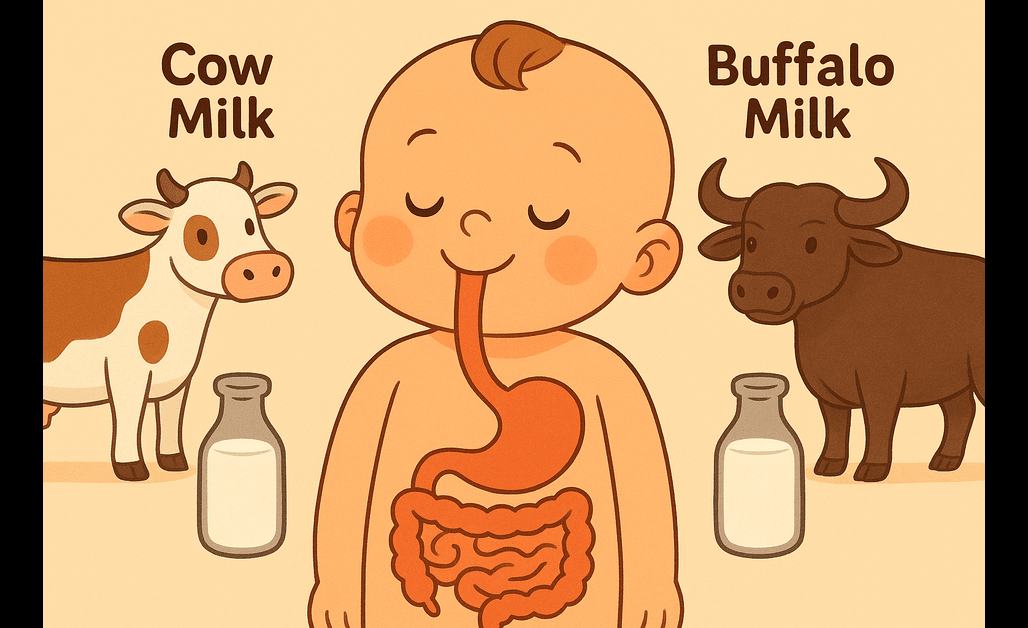
JUN
23
Introduction

Cow Milk vs. Buffalo Milk
For centuries, milk has been considered one of the most important foods for growth, development, and nourishment. In many cultures, milk is regarded as a “complete food,” providing essential nutrients like protein, calcium, fats, and vitamins. Cow Milk vs. Buffalo Milk When it comes to babies and toddlers, parents often wonder: Which milk is better—cow milk or buffalo milk?
This debate is especially common in South Asian countries such as India, where both cow and buffalo milk are widely consumed. Parents want to ensure that the milk they give their children supports healthy growth, strengthens bones, and aids digestion—without causing problems like allergies, constipation, or obesity.
This article takes an in-depth look at cow milk vs. buffalo milk for babies, analyzing their nutritional content, digestibility, health benefits, and risks. By the end, you’ll have a clear, research-backed understanding of which milk may be more suitable for your child.
Understanding Milk and Infant Nutrition
Why Milk Matters for Babies
During the first year of life, breast milk is considered the gold standard of nutrition. It contains the perfect balance of proteins, fats, vitamins, minerals, and antibodies. However, once babies grow past 12 months, parents begin introducing animal milk as part of their child’s diet.
Milk provides:
-
Proteins – Essential for muscle and tissue growth.
-
Fats – Provide energy and help brain development.
-
Calcium & Phosphorus – Build strong bones and teeth.
-
Vitamins A, D, B12 – Crucial for immunity, vision, and blood health.
WHO and AAP Guidelines
-
The World Health Organization (WHO) recommends exclusive breastfeeding for the first 6 months of life.
-
The American Academy of Pediatrics (AAP) suggests avoiding cow’s milk before 12 months because it lacks iron and may increase the risk of anemia.
-
After 1 year, whole milk (cow or buffalo) can be introduced gradually in controlled amounts.
Cow Milk – Composition & Benefits
Cow milk is one of the most commonly consumed types of milk worldwide. For babies above one year, it offers several nutritional benefits.
Nutritional Profile of Cow Milk (per 100ml)
-
Energy: 60–70 kcal
-
Protein: 3.2g
-
Fat: 3.5g
-
Carbohydrates (mainly lactose): 4.8g
-
Calcium: 120mg
-
Vitamin A, B12, D, Riboflavin
Benefits of Cow Milk for Babies
-
Easier to Digest – Cow milk has a lower fat content and smaller fat globules, making it lighter for babies’ stomachs.
-
Good for Bones – Provides a balanced amount of calcium and vitamin D for bone growth.
-
Supports Healthy Weight – Moderate fat helps prevent obesity.
-
Widely Available – Readily accessible and often fortified.
Cultural Importance
In India, cow milk is traditionally seen as sattvic (pure, calming, and beneficial), making it a preferred choice for children.
Buffalo Milk – Composition & Benefits
Buffalo milk is thicker, creamier, and richer compared to cow milk. It is popular in South Asia, where it is often consumed as whole milk or processed into paneer, khoa, and ghee.
Nutritional Profile of Buffalo Milk (per 100ml)
-
Energy: 95–100 kcal
-
Protein: 4.5g
-
Fat: 6.5–7g
-
Carbohydrates: 4.9g
-
Calcium: 190mg
-
Vitamin A, B12, Magnesium, Phosphorus
Benefits of Buffalo Milk for Babies
-
Higher Energy Content – Supports babies who need weight gain or have higher energy needs.
-
Rich in Calcium & Minerals – Strengthens bones and teeth.
-
Good for Immunity – Contains more protein and bioactive compounds.
-
Keeps Babies Full Longer – High fat makes it more satiating.
Traditional Uses
In India and Pakistan, buffalo milk is often used for toddlers needing stronger bones or extra weight gain.
Cow Milk vs. Buffalo Milk: Key Differences
| Nutrient/Factor | Cow Milk | Buffalo Milk | Which is Better for Babies? |
|---|---|---|---|
| Energy | 60–70 kcal | 95–100 kcal | Buffalo (for weight gain) |
| Protein | 3.2g | 4.5g | Buffalo (but heavier to digest) |
| Fat | 3.5g | 6.5–7g | Cow (easier digestion) |
| Calcium | 120mg | 190mg | Buffalo (bone health) |
| Digestibility | Easier | Harder (heavier casein) | Cow |
| Satiety | Moderate | High (keeps baby full) | Buffalo |
Which Milk is Easier for Babies to Digest?
-
Cow Milk has a higher whey-to-casein protein ratio, making it gentler on the stomach.
-
Buffalo Milk contains more casein (heavier protein), which can cause constipation in some babies.
👉 Verdict: Cow milk is easier for digestion, especially for younger toddlers. Buffalo milk may be suitable after 2 years, depending on digestion.
Risks & Concerns of Introducing Milk Too Early
-
Introducing cow or buffalo milk before 1 year can cause:
-
Iron deficiency anemia
-
Increased risk of allergies
-
Strain on immature kidneys
-
Digestive issues (diarrhea, constipation)
-
Pediatricians strongly recommend exclusive breastfeeding or formula feeding until the first birthday.
When & How to Introduce Cow or Buffalo Milk
-
Start after 12 months of age.
-
Introduce gradually – Mix small amounts with solid foods or porridge.
-
Limit quantity – About 400–500ml/day is enough.
-
Always boil or pasteurize milk before serving.
Cow Milk vs. Buffalo Milk for Babies Over 1 Year
-
For digestive comfort → Cow milk is better.
-
For weight gain & bone strength → Buffalo milk may help.
-
Some parents use a mix of cow and buffalo milk to balance nutrition.
Case Example:
-
A pediatric clinic in Delhi reported that underweight toddlers improved with buffalo milk due to its high fat and calorie content.
-
On the other hand, children prone to constipation were switched to cow milk, which eased digestion.
Expert Opinions & Research Studies
-
A study published in the Journal of Food Science & Technology found buffalo milk to have more fat and calcium but lower digestibility than cow milk.
-
The Indian Academy of Pediatrics recommends cow milk as the first choice for toddlers because of better digestibility.
-
WHO continues to emphasize that no animal milk should replace breast milk in the first 6 months.
Alternatives for Babies with Milk Allergies/Intolerance
-
Lactose-Free Cow Milk – Easier to digest for lactose-sensitive toddlers.
-
Soy Milk – Plant-based, protein-rich.
-
Almond/Oat Milk – Good for mild intolerance (but low in protein).
-
Hydrolyzed Formula – For severe cow’s milk protein allergy.
Frequently Asked Questions (FAQs)
Q1: Can a 6-month-old baby have cow milk?
👉 No, only breast milk or formula is recommended.
Q2: Is buffalo milk too heavy for toddlers?
👉 Yes, its high fat and casein make it harder to digest.
Q3: Which milk is better for weight gain?
👉 Buffalo milk, due to higher fat and calories.
Q4: Does buffalo milk cause constipation in babies?
👉 It can, because of higher casein content.
Q5: Should parents boil milk before giving it to babies?
👉 Yes, always boil raw milk to kill harmful bacteria.